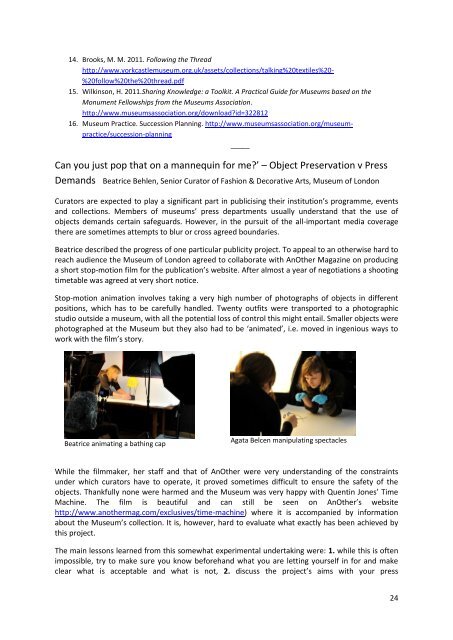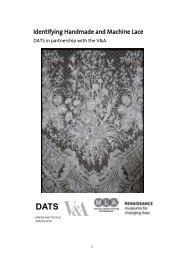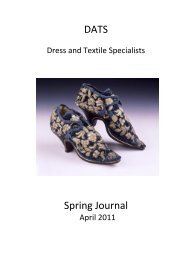Spring 2012 - Dress and Textile Specialists
Spring 2012 - Dress and Textile Specialists
Spring 2012 - Dress and Textile Specialists
You also want an ePaper? Increase the reach of your titles
YUMPU automatically turns print PDFs into web optimized ePapers that Google loves.
14. Brooks, M. M. 2011. Following the Thread<br />
http://www.yorkcastlemuseum.org.uk/assets/collections/talking%20textiles%20-<br />
%20follow%20the%20thread.pdf<br />
15. Wilkinson, H. 2011.Sharing Knowledge: a Toolkit. A Practical Guide for Museums based on the<br />
Monument Fellowships from the Museums Association.<br />
http://www.museumsassociation.org/download?id=322812<br />
16. Museum Practice. Succession Planning. http://www.museumsassociation.org/museumpractice/succession-planning<br />
_____<br />
Can you just pop that on a mannequin for me?’ – Object Preservation v Press<br />
Dem<strong>and</strong>s Beatrice Behlen, Senior Curator of Fashion & Decorative Arts, Museum of London<br />
Curators are expected to play a significant part in publicising their institution’s programme, events<br />
<strong>and</strong> collections. Members of museums’ press departments usually underst<strong>and</strong> that the use of<br />
objects dem<strong>and</strong>s certain safeguards. However, in the pursuit of the all-important media coverage<br />
there are sometimes attempts to blur or cross agreed boundaries.<br />
Beatrice described the progress of one particular publicity project. To appeal to an otherwise hard to<br />
reach audience the Museum of London agreed to collaborate with AnOther Magazine on producing<br />
a short stop-motion film for the publication’s website. After almost a year of negotiations a shooting<br />
timetable was agreed at very short notice.<br />
Stop-motion animation involves taking a very high number of photographs of objects in different<br />
positions, which has to be carefully h<strong>and</strong>led. Twenty outfits were transported to a photographic<br />
studio outside a museum, with all the potential loss of control this might entail. Smaller objects were<br />
photographed at the Museum but they also had to be ‘animated’, i.e. moved in ingenious ways to<br />
work with the film’s story.<br />
Beatrice animating a bathing cap<br />
Agata Belcen manipulating spectacles<br />
While the filmmaker, her staff <strong>and</strong> that of AnOther were very underst<strong>and</strong>ing of the constraints<br />
under which curators have to operate, it proved sometimes difficult to ensure the safety of the<br />
objects. Thankfully none were harmed <strong>and</strong> the Museum was very happy with Quentin Jones’ Time<br />
Machine. The film is beautiful <strong>and</strong> can still be seen on AnOther’s website<br />
http://www.anothermag.com/exclusives/time-machine) where it is accompanied by information<br />
about the Museum’s collection. It is, however, hard to evaluate what exactly has been achieved by<br />
this project.<br />
The main lessons learned from this somewhat experimental undertaking were: 1. while this is often<br />
impossible, try to make sure you know beforeh<strong>and</strong> what you are letting yourself in for <strong>and</strong> make<br />
clear what is acceptable <strong>and</strong> what is not, 2. discuss the project’s aims with your press<br />
24





